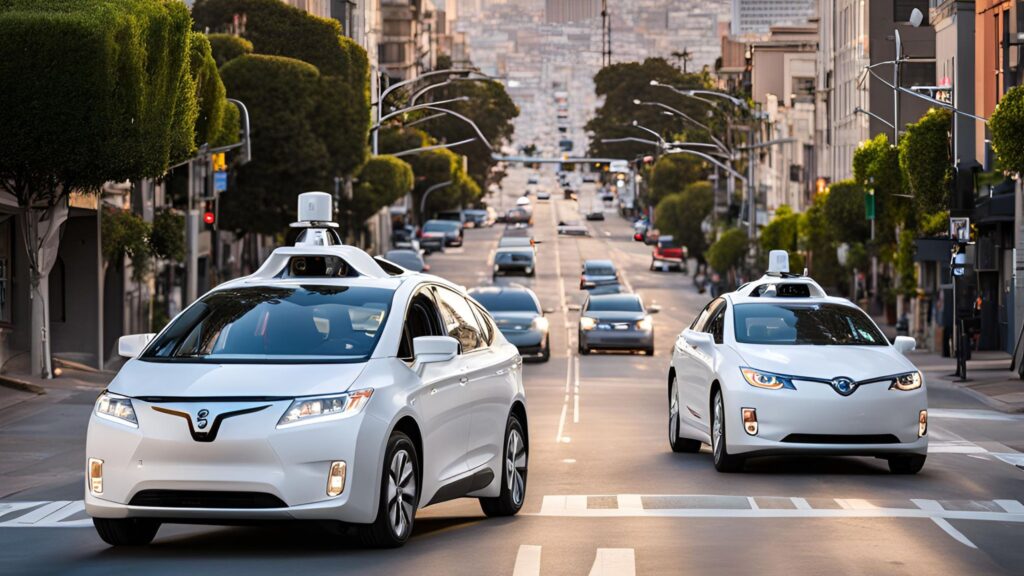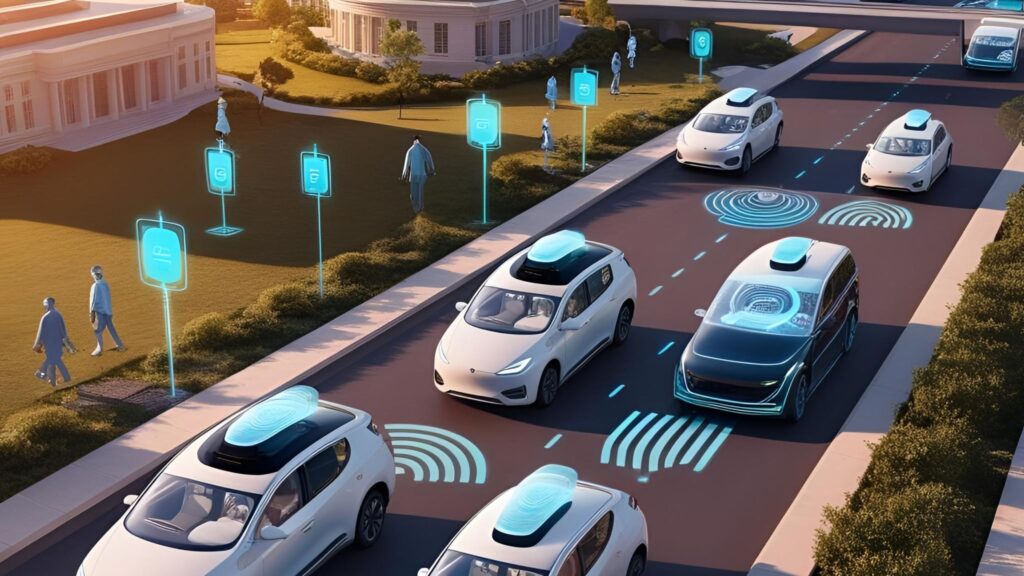The first quarter of 2025 has been a pivotal period for autonomous vehicle (AV) technology in the United States. From regulatory advancements to major industry breakthroughs, self-driving cars have continued their rapid evolution. The AV sector, projected to be worth $2.1 trillion by 2030, is already shaping the future of mobility.
In the past three months, automakers and tech firms have accelerated real-world testing, with autonomous miles driven surpassing 100 million—a stark increase from the 65 million miles recorded in 2024. States like California, Texas, and Arizona remain at the forefront, hosting extensive trials and regulatory discussions. Meanwhile, federal agencies have been refining safety frameworks, leading to key legislative developments that could dictate the industry’s growth going forward.
The first quarter saw major announcements from leading AV companies such as Waymo, Zoox, and Tesla, each unveiling enhanced AI-driven driving capabilities and talking service expansion.
Investments in self-driving technology have exceeded $12 billion in the first quarter alone. Multiple startups have secured record-breaking funding rounds, as the industry experiences unprecedented momentum.
This article provides an in-depth autonomous vehicle roundup fromJanuary to March 2025, exploring key technological advancements, policy changes, corporate strategies, and the broader implications for the future of self-driving cars.
Autonomous Vehicles Roundup (January – March 2025)
Waymo
Waymo, a frontrunner in the autonomous vehicle (AV) industry, has made significant strides from January to March 2025, reinforcing its position as a leader in the robotaxi space.
Waymo kicked off the year with a notable expansion of its fully autonomous operations. On January 30, 2025, the company announced that it had begun offering fully autonomous rides to its employees in Atlanta, Georgia. This marked Waymo’s entry into a new major U.S. market, building on its established presence in cities like San Francisco, Phoenix, Los Angeles, and Austin. The Atlanta rollout leverages Waymo’s fifth-generation Waymo Driver technology, which has already accumulated over 33 million miles of autonomous driving experience across these regions.
Waymo’s fleet, comprising all-electric Jaguar I-PACE vehicles, has continued to maintain its reputation for safety and efficiency, with no significant incidents reported during this period that would have disrupted its momentum. Waymo likely used February to refine its Atlanta operations and prepare for regulatory approvals elsewhere, consistent with its methodical approach to expansion.
Still in the first quarter, Waymo reached a new milestone: serving over 200,000 paid trips across San Francisco, Los Angeles, and Phoenix. This feat amounts to 20x growth in less than two years, according to Alphabet’s CEO Sundar Pichai on X.
On March 18, 2025, the California Department of Motor Vehicles (DMV) granted Waymo approval to operate its fully autonomous vehicles in an expanded South Bay region, covering most of San Jose and additional areas beyond its prior Peninsula and San Francisco domains. This approval, detailed in a California DMV autonomous vehicle testing permit update, allows Waymo to deploy its driverless vehicles without human safety operators in these zones. However, as of March 26, 2025, this expansion is not yet open to the public; Waymo is working with local policymakers, first responders, and community stakeholders to ensure a smooth rollout. The company emphasized its collaborative approach, noting ongoing discussions to finalize public access timelines.
On March 25, 2025, Waymo announced plans to bring the Waymo robotxi experience in 2026, culminating in a terrific first-quarter experience for the Alphabet-owned company.
Zoox
Zoox kicked off the year with a strong presence at CES 2025 in Las Vegas, held from January 7-10. The company showcased its purpose-built, toaster-shaped robotaxi, offering demo rides along the Las Vegas Strip to journalists and attendees. Reports from TechCrunch and PCMag on January 8 and 10 highlighted the vehicle’s smooth handling of complex scenarios—such as navigating construction zones, car crashes, and pedestrians—though it exhibited occasional hesitation around traffic cones.
These rides signaled Zoox’s readiness to transition from testing to public operations, with the company announcing plans to open its robotaxi service to the public in Las Vegas and San Francisco “later in 2025.”
Co-founder and CTO Jesse Levinson, speaking at CES on January 17 (per NBC News), emphasized Zoox’s intent to “significantly” grow its fleet—then a couple dozen vehicles—and commercialize its business, marking 2025 as a pivotal year.
On February 8, The Verge reported on a hands-on experience in Las Vegas, describing the robotaxi as “safe but conservative,” suggesting Zoox was still fine-tuning its autonomous driving system (ADS) for broader deployment. The company had been testing its custom robotaxis in San Francisco’s SoMa neighborhood since late 2024, and by February, it extended this to additional public roads in the Bay Area, Seattle, Austin, and Miami.
A Mashable article on February 20 noted Zoox’s growing presence alongside competitors like Waymo, highlighting its measured rollout strategy.
Zoox’s focus on safety was evident in its testing fleet, which includes both its purpose-built robotaxis and retrofitted Toyota Highlanders. The company’s approach—building a vehicle from the ground up for autonomy—sets it apart from rivals retrofitting traditional cars, though it also increases development complexity and cost, as Levinson acknowledged.
On March 11, The Washington Post reported that Zoox’s robotaxi failed to meet U.S. Federal Motor Vehicle Safety Standards (FMVSS) due to its lack of traditional controls like brake pedals and rearview mirrors. The National Highway Traffic Safety Administration (NHTSA) identified “apparent noncompliances” with eight safety rules, raising questions about Zoox’s self-certification process from 2022, which remains under review.
Zoox countered that its AI-driven design doesn’t rely on human-centric equipment, but the findings suggest regulatory hurdles could delay its commercial timeline unless NHTSA reinterprets its rules—a process industry groups have pushed for since January.
A more immediate challenge emerged on March 19, when Zoox agreed to a voluntary recall of software in 258 vehicles due to unexpected hard braking issues, as reported by Reuters, TechCrunch, and Yahoo Finance. Stemming from two May 2024 rear-end collisions involving motorcyclists during testing, the NHTSA investigation prompted Zoox to update its ADS software (versions pre-November 5, 2024) by November 7, 2024, resolving the issue.
Zoox framed the recall as a transparency move, with no further incidents reported by March. X posts on March 19 and 20 reflected mixed sentiment, with some praising Zoox’s proactive stance and others questioning the safety of self-driving tech.
On March 20, Zoox highlighted its leadership, with VP of Autonomy Software Marc Wimmershoff—a Tesla Autopilot alum—leading efforts to scale its software, per an X post. Meanwhile, a March 21 Road to Autonomy X post noted Zoox’s plans to build an autonomous vehicle depot near Austin-Bergstrom International Airport, signaling infrastructure investment for future Texas operations.
May Mobility
May Mobility kicked off the year with a strong presence at CES 2025 in Las Vegas, held from January 7-10. The company extended its portfolio of AV use cases by demonstrating its autonomous Toyota Sienna minivans, equipped with its proprietary Multi-Policy Decision Making (MPDM) system.
A press release from January 7 (via PR Newswire) highlighted a new partnership with an undisclosed corporate client to launch an autonomous vehicle service, emphasizing May Mobility’s growing business-to-business (B2B) traction. The CES event also served as a platform to showcase the company’s safety record—over 335,000 autonomy-enabled rides across 11 cities in the U.S. and Japan by late 2024—positioning it as a reliable player in the AV space.
On February 12, May Mobility and Lyft jointly revealed plans to integrate autonomous vehicles into the Lyft app, targeting a public rollout in Atlanta by summer 2025.
A February 4 case study on its website detailed the success of its second driverless operation in the U.S., launched in Ann Arbor, Michigan, in late 2024, which transitioned to fully autonomous service by February 2025. This milestone reinforced May Mobility’s goal of achieving driver-out commercial operations, a target initially set for 2023 but refined through iterative deployments.
On March 20, the company confirmed its 2025 Atlanta launch with Lyft, detailing plans to deploy a fleet of autonomous Toyota Siennas in a geofenced area of the city.
Nuro
Nuro entered 2025 building on its late-2024 momentum, particularly its November 19, 2024, announcement of expanded Level 4 (L4) driverless operations in three cities—Palo Alto and Mountain View, California, and Houston, Texas.
At CES 2025 (January 7-10), Nuro maintained a presence, though it didn’t dominate headlines like competitors Zoox or May Mobility. Posts on X from January 8 suggested Nuro showcased its third-generation delivery vehicle and discussed its licensing model, introduced in September 2024, which allows automotive OEMs and mobility providers to adopt the Nuro Driver for various applications. This aligns with CEO Jiajun Zhu’s vision, reiterated in a November 2024 PR Newswire release, of scaling autonomy beyond delivery into passenger vehicles and robotaxis.
Operationally, Nuro continued to support its partnerships, such as the 10-year Uber Eats deal from September 2022 and the Kroger delivery service in Houston (expanded in November 2024). A February 10 X post speculated that Nuro’s Houston operations might integrate new night-operation capabilities—enabled in late 2024—into these services, though no official confirmation emerged.
A March 19 Medium post by the Nuro Team teased “exciting new technical milestones” to be revealed in the coming months.
Kodiak Robotics
In early January, Kodiak Robotics announced it had sold its driverless “RoboTrucks” to Atlas Energy Solutions for use in the Permian Basin, a major oil and gas region spanning Texas and New Mexico. By January 15, a FreightWaves report confirmed that Atlas had completed delivery of 100 loads using Kodiak-equipped Class 8 trucks, demonstrating safe, driverless operations in real-world logistics. These trucks, powered by the Kodiak Driver—an AI-driven autonomy system—represent Kodiak’s first commercial sale of fully autonomous vehicles, building on its prior partnership with Atlas announced in August 2024.
On March 14, Yahoo Finance and The Information reported that Kodiak Robotics was in advanced talks to merge with Ares Acquisition Corp. II, a special purpose acquisition company (SPAC), in a deal valuing the post-merger entity at approximately $2 billion. Bloomberg sources indicated that Ares was seeking shareholder approval to extend its merger deadline beyond April 25, 2025, signaling confidence in finalizing the transaction. This potential merger, if completed, would provide Kodiak with substantial capital to accelerate its driverless deployments and compete with larger players.
Kodiak has continued to scale its Permian Basin operations, leveraging its hub-to-hub autonomous trucking model. This model, which avoids complex urban environments by focusing on highway routes, aligns with Kodiak’s strategy of achieving commercial viability ahead of competitors.
Aurora Innovation
Aurora kicked off the year with a major partnership announcement. On January 11, the company revealed a long-term collaboration with NVIDIA and Continental to deploy driverless trucks at scale, integrating NVIDIA’s DRIVE Thor system-on-chip (based on the Blackwell architecture) into its Aurora Driver platform. This deal aims to begin mass manufacturing in 2027, with Continental producing the hardware. The announcement sent Aurora’s stock surging over 35% that day, reflecting investor confidence in its technological and commercial development.
On the regulatory front, Aurora took a bold step by filing a lawsuit against the Biden administration on January 14. The suit, lodged with the District of Columbia Court of Appeals, challenges Federal Motor Carrier Safety Administration (FMCSA) rules requiring stopped trucks to use physical warning triangles—a human-centric requirement Aurora argues is outdated for AVs.
Aurora, alongside Waymo (from its now-defunct trucking unit), had sought an exemption in 2023 to use cab-mounted flashing beacons instead, but the FMCSA denied it, citing safety concerns from limited studies. This legal battle, ongoing as of March, underscores Aurora’s push to adapt regulations for its April 2025 driverless launch.
In February, Aurora confirmed plans to begin driverless trucking operations between Dallas and Houston in April 2025, starting with a small fleet of up to 10 trucks. The trucks would have the ability to handle highway challenges like police interactions and construction zones, honed through extensive testing.
At the NVIDIA GTC conference (March 17-20), Aurora participated in an AV Safety Day on March 18, reinforcing its safety-first ethos (NVIDIA blog). On March 25, Aurora released its Driverless Safety Report, detailed by MarketScreener and GuruFocus, outlining its safety engineering, cybersecurity, and risk management frameworks.
Gatik
Gatik entered 2025 building on its late-2024 momentum, particularly its October 2024 commitment to a rigorous third-party safety review by Edge Case Research and TÜV SÜD, aimed at validating its Freight-Only operations for a planned driverless debut in North Texas.
In early January, Gatik continued testing its Class 3-7 autonomous box trucks in multiple markets—Texas, Arkansas, Arizona, and Ontario—where it has been commercially deployed for clients like Walmart, Kroger, and Tyson Foods.
A January 9 Fort Worth Report noted Gatik’s presence in Hillwood’s Mobility Innovation Zone at AllianceTexas, alongside Torc, signaling its intent to deepen operations in the Dallas-Fort Worth area, a key logistics hub.
In the first quarter, Gatik densified its network in existing markets. Its partnership with Isuzu North America, strengthened by a 2024 investment, laid the groundwork for mass production
On March 18, Gatik announced it would develop and deploy the NVIDIA DRIVE AGX in-vehicle compute architecture, accelerated by the DRIVE Thor system-on-chip (SoC), across its fleet of Class 6 and 7 Freight-Only vehicles. This collaboration, unveiled at Nvidia’s GTC conference (March 17-20), builds on Gatik’s existing tie with Isuzu and aims to mass-produce Level 4 autonomous trucks. This partnership would accelerate deployment for Gatik’s Fortune 500 customers—Walmart, Kroger, Tyson Foods—enabling higher-frequency deliveries and lower costs.
Tesla
Tesla started the year with bold AV-related plans outlined in its Q4 2024 earnings call (covering October-December 2024, reported in late January). Musk reiterated a timeline for launching an autonomous robotaxi service in Austin, Texas, by June 2025, aiming for Level 4 (L4) autonomy in a geofenced area, alongside unsupervised FSD across most U.S. markets by year-end, pending regulatory approval.
Posts on X from January 20-21 speculated about a fleet-wide autonomy update leveraging 50,000 to 100,000 GPUs, though no specifics were confirmed beyond Musk’s optimism.
A significant admission came during a shareholder call around January 23, when Musk acknowledged that vehicles with Hardware 3 (HW3), installed from 2019-2023, cannot achieve unsupervised FSD without upgrades. This reversed years of promises that all Teslas since 2016 were autonomy-ready, sparking backlash among owners who paid $8,000-$15,000 for FSD packages.
The shift refocused Tesla on its next-gen Cybercab robotaxi, unveiled in October 2024 as a steering-wheel-free vehicle slated for 2026 production at under $30,000.
The California Public Utilities Commission (CPUC) granted Tesla a Transportation Charter-Party Carrier (TCP) permit on March 18, a prerequisite for ride-hailing services. This allows Tesla to manage a fleet and transport employees, a step toward robotaxis, though it doesn’t yet authorize public autonomous rides. Tesla still needs CPUC and California DMV permits for driverless operations, with experts estimating a year-long process.
Tesla recently shed light on key details about its upcoming Cybercab robotaxi, particularly regarding its battery pack and range, addressing concerns about range anxiety that often accompany electric vehicles (EVs), especially autonomous ones designed for continuous operation.
In mid-March 2025, Tesla executives Lars Moravy (VP of Vehicle Engineering) and Franz von Holzhausen (Senior Design Executive) revealed to manufacturing expert Sandy Munro that the Tesla Cybercab will feature a battery pack smaller than 50 kWh—potentially as low as 48 kWh based on earlier speculation from October 2024 image analysis. This is a notably compact size compared to Tesla’s other offerings, like the Model 3 Long Range’s 75 kWh pack or the Cybertruck’s 122.4 kWh capacity.
Despite this smaller battery, Tesla claims the Cybercab will achieve a real-world range of “close to” 300 miles, translating to an industry-leading efficiency of approximately 6 miles per kWh.
For context, the Model 3 achieves about 4 miles per kWh, and even the highly efficient Lucid Air Pure tops out at 4.3 miles per kWh. This efficiency leap is attributed to the Cybercab’s aerodynamic teardrop design, lightweight two-seater configuration, and optimized wheel covers—features honed to minimize energy consumption.
To tackle range anxiety (the fear of running out of power before reaching a destination), Tesla announced at the October 2024 “We, Robot” event, that the Cybercab will use inductive charging, eliminating the need for a physical plug. This allows the vehicle to autonomously recharge at designated pads during downtime—such as after dropping off passengers—without human assistance. While charging speeds remain undisclosed, Tesla’s acquisition of a German inductive charging firm in 2023 (offering 22 kW at 97% efficiency) hints at practical recharge rates.
Elon Musk’s goal for the Cybercab is a $25,000-$30,000 retail price by 2026.
Conclusion
The first quarter of 2025 has been pivotal for the autonomous vehicle (AV) industry in the U.S., marked by regulatory shifts, technological advancements, and strategic partnerships. Companies like Waymo and Aurora Innovation continue expanding their robotaxi services despite regulatory scrutiny, while Tesla’s Full Self-Driving (FSD) improvements highlight the industry’s ongoing push toward Level 4 autonomy.
Regulatory agencies, particularly the National Highway Traffic Safety Administration (NHTSA) and the California Department of Motor Vehicles, have tightened oversight, responding to safety concerns surrounding AV deployments. This follows a reported 12% increase in AV-related incidents in Q1, according to preliminary data from the NHTSA, emphasizing the industry’s need for enhanced safety protocols and real-world validation.
On the investment front, venture capital funding for AV startups has rebounded, with over $3.8 billion raised in Q1 2025, signaling renewed confidence in self-driving technology.
Looking ahead, Q2 2025 is expected to bring further regulatory clarity, expanded commercial deployments, and breakthroughs in vehicle-to-everything (V2X) communication. While challenges remain—ranging from public trust to urban integration—one thing is clear: the AV industry is accelerating toward a transformative future, redefining mobility in the U.S. and beyond.
You May Also Like:
Must-Read: Top 10 Autonomous Vehicle Trends (2025)
Women in the US are Turning to Driverless Taxis Over Rideshare Services. Here’s Why!

I’m Dr. Brandial Bright, also known as the AVangelist. As a dedicated and passionate researcher in autonomous and electric vehicles (AVs and EVs), my mission is to educate and raise awareness within the automotive industry. As the Founder and Managing Partner of Fifth Level Consulting, I promote the adoption and innovation of advanced vehicle technologies through speaking engagements, consulting, and research as we progress to level 5 fully autonomous vehicles.


